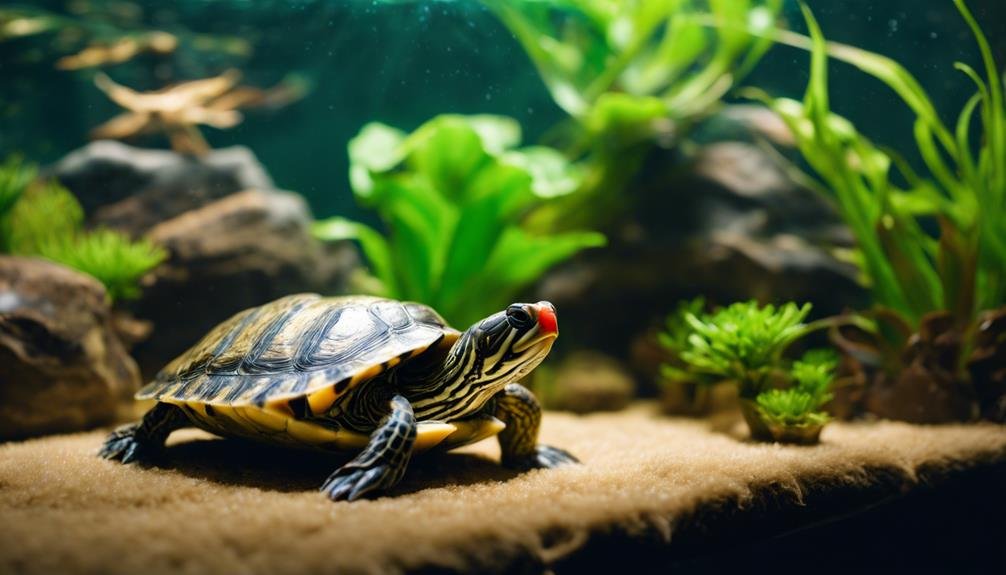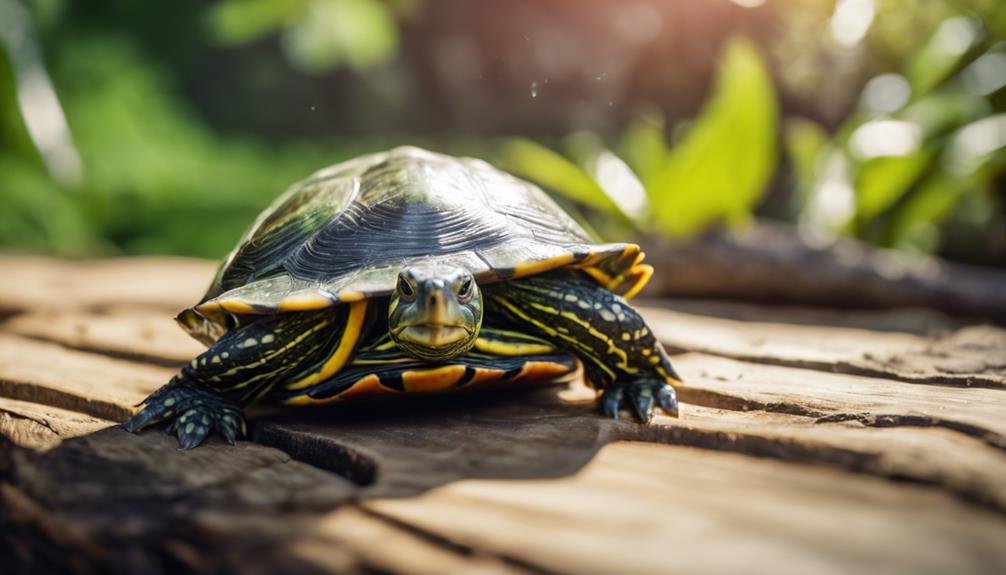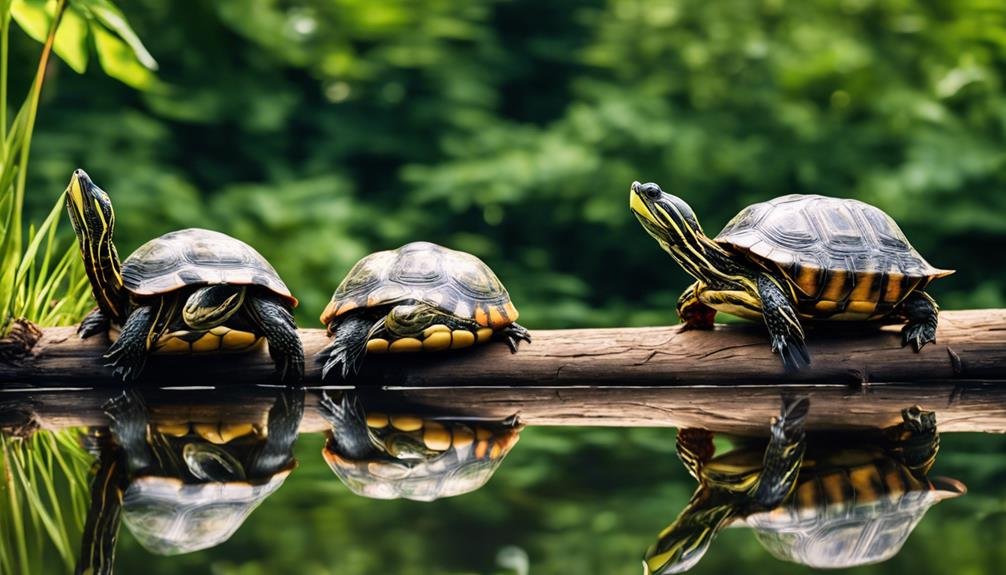When considering the lifespan of red-eared sliders, it’s important to understand that their longevity hinges on more than just basic care. You’ll need to provide a habitat that closely mimics their natural environment, including UV lighting and proper temperature regulation, alongside a balanced diet and regular vet check-ups. While it’s widely known that these practices are essential, the nuances in their execution can greatly impact your turtle’s health and lifespan. As we explore these key factors, you’ll discover that achieving a happy, healthy life for your red-eared slider involves a deeper commitment than you might initially think.
Key Takeaways
- To ensure essential nutrient intake, provide a balanced diet, including turtle pellets, vegetables, and occasional treats.
- Maintain a high-quality habitat with proper UV lighting, temperature regulation, and at least 10 gallons of water per inch of shell length.
- Regular veterinary check-ups are essential for preventing and monitoring health issues, contributing to a longer lifespan.
- Ensure clean water and a hygienic environment by utilizing effective filtration systems and performing frequent water quality tests.
- Encourage natural behaviors through ample swimming and basking space, promoting physical and mental well-being. Lifespan Variability
It’s important to consider factors such as diet, habitat quality, and healthcare practices to comprehend why red-eared sliders’ lifespans vary so widely. As a pet owner, you ensure your slider’s environment mimics their natural habitat as closely as possible. Ideal conditions, including proper UV lighting and temperature regulation, are essential for their well-being. Elements affect their physical health and play a significant role in their longevity.
Feeding your red-eared slider a balanced diet is another cornerstone of proactive care. Like humans, these turtles thrive on variety and nutrition, directly influencing their lifespan. Additionally, regular veterinary check-ups can’t be overlooked. These visits are your frontline defense against potential health issues, ensuring your pet remains in peak condition.
Achieving a high-quality habitat isn’t just about meeting basic needs; it’s about creating an environment where your red-eared slider can flourish. With diligent healthcare practices and a commitment to providing the best possible care, you’re setting the stage for your turtle to outlive the average lifespan, pushing beyond the 20 to 30-year range and perhaps even reaching those remarkable ages beyond 70 years under the most favorable conditions.
Essential Care Requirements
Understanding the various factors that impact the lifespan of red-eared sliders, let’s now focus on their care requirements to guarantee they thrive. You must prioritize their well-being and meticulous care to ensure your red-eared sliders live a long, happy life. Here are three essential aspects to take into account:
- Veterinary Check-ups and Diet: Regular veterinary visits are vital for detecting and treating potential health issues early. A balanced diet rich in vitamins and minerals supports their overall health, greatly influencing their lifespan.
- Proper Lighting and Heating: UVB lighting is crucial for red-eared sliders metabolizing calcium and maintaining healthy shells. Equally important is creating a warm environment with the right heating and a basking area where they can regulate their body temperature.
- Space and Habitat Maintenance: Adequate space allows for free movement and exercise, which is important for their physical health and stress reduction. Regular habitat maintenance ensures a clean and safe environment, free from harmful bacteria or pollutants that can affect their health.
Optimal Habitat Setup


Understanding the importance of tank size and water quality management is key to creating an ideal habitat for your red-eared slider.
You’ll need to select a tank that provides enough space for swimming, a basking area, and a robust water filtration system to keep the environment clean and healthy.
Regular monitoring and adjustments to the water temperature, pH, and nitrate levels are essential to guaranteeing your turtle’s thriving.
Tank Size Requirements
To ensure your red-eared slider thrives, choosing a tank size that meets their specific needs is important. Understanding the relationship between a red-eared slider’s shell length and the tank size is significant for their well-bewellbeingare key points to remember:
- Tank Size: Red-eared sliders require at least 10 gallons per inch of shell length.
- Adult Size: Aim for a 75-125 gallon tank for adult sliders.
- Benefits: A larger tank offers ample swimming space and supports proper basking areas.
Inadequate tank sizes can lead to stress, health issues, and stunted growth. Ensuring the appropriate tank size is important for the health and well-being of red-eared sliders, preventing potential health issues and contributing to their overall happiness and longevity.
Water Quality Management
Maintaining excellent water quality is essential for your red-eared slider’s health and longevity. Proper filtration systems are key to removing waste and debris and keeping your turtle’s habitat pristine.
You’ll need to regularly test the water for pH, ammonia, and nitrate levels to ensure the environment is safe. Clean water minimizes the risk of bacterial growth and protects your turtle from infections and shell diseases. It’s important for their well-being.
Nutrition and Feeding Practices
Ensuring your red-eared slider enjoys a balanced diet is vital for its health and longevity. As pets, red-eared sliders have specific nutritional needs that, when met, can prevent health issues and promote a vibrant life. Feeding them involves more than just providing food; it’s about understanding what constitutes a healthy diet for these aquatic creatures.
To grab your attention, here are three key practices for feeding your red-eared slider:
- Offer a mix of commercial turtle pellets, vegetables, and occasional treats to ensure they receive a balanced diet.
- Feed outside the tank to maintain water cleanliness and reduce the risk of contamination.
- Incorporate calcium supplements and vitamin D3 into their diet to support their health and overall well-being. Overfeeding is critical to prevent obesity, a common health issue in red-eared sliders. Consulting a veterinarian for specific dietary requirements can guide you in providing the proper nutrition your pet needs. Remember, a well-balanced diet, including calcium supplements and vitamin D3, along with careful feeding practices, will keep your red-eared sliders healthy and prevent obesity, ensuring their longevity and your enjoyment of these fascinating pets.
Health and Common Issues


After covering nutrition and feeding practices, let’s tackle the health concerns and frequent issues you might encounter with your red-eared slider. These aquatic turtles, while hardy, can face several health problems if their environment and care aren’t up to par.
A major concern is the risk of salmonella, which requires good hygiene, like washing your hands after handling your slider. Gastrointestinal parasites are another issue that can affect your turtle’s health, often necessitating veterinary intervention.
Respiratory infections can arise, particularly if your turtle’s basking area isn’t warm enough or if the water quality is poor. Symptoms include lethargy, wheezing, and difficulty breathing, signaling it’s time for a vet visit.
Shell rot and ulcers, painful conditions often caused by fungal or bacterial infections, can severely affect your slider’s well-being and are typically the result of dirty tank conditions or injuries.
Maintaining a clean tank, ensuring proper basking and aquatic areas, and regular vet check-ups are critical. Educating yourself on these common issues and staying vigilant for signs of illness will help keep your red-eared slider healthy and thriving for years.
Enhancing Quality of Life
It’s important to provide a balanced diet and proper nutrition to enhance the quality of life for your red-eared slider. This species thrives on a variety of foods that mirror its natural diet, ensuring it receives all the necessary nutrients to maintain its health and vitality.
To grab your attention, here’s how you can greatly improve their living conditions:
- Maintain a clean and odor-free tank environment: Regular cleaning prevents the buildup of harmful bacteria and keeps the water quality high, creating a safe habitat for your turtle.
- Provide a basking area with the right temperatures: Access to a properly heated basking spot is essential for your slider’s physical well-bewellbeinglows them to thermoregulate and exhibit natural behaviors crucial for their happiness.
- Schedule regular veterinary check-ups: Preventing and monitoring common health issues through professional care ensures your turtle stays healthy and lives a longer, happier life.
Incorporating these practices prevents stress and encourages your red-eared slider to engage in natural behaviors, greatly enhancing their quality of life. Remember, a balanced diet, a well-maintained tank environment, and periodic veterinary check-ups are key to their overall well-being. Does Breathing Underwater Affect the Lifespan of Red-Eared Sliders?
Red-eared sliders’ breathing underwater affects their lifespan, as they must come to the surface to breathe air. They may experience health issues and a shortened lifespan without proper access to oxygen. Therefore, ensuring they can access land and water is crucial for longevity.
Conclusion
To sum up, diligent care can greatly extend the life of your red-eared slider. By understanding their needs, setting up the perfect habitat, and following a nutritious diet, you’re laying the groundwork for a long, joyful life.
Remember the importance of regular health checks to nip any issues in the bud. Investing time and love into your turtle’s well-being truly enhances its quality of life, ensuring your turtle thrives for years to come.
FAQs
1. What Makes a Red-Eared Slider Happy?
Focus on your red-eared slider’s environment and diet to make them happy. Start with a spacious habitat that includes plenty of swimming and basking areas. Then, guarantee the water quality, temperature, and lighting are just right.
A varied and nutrient-rich diet is key. Also, while they enjoy some interaction, remember to keep handling to a minimum to avoid stress. Lastly, make their space safe and free from hazards.
2. How Do I Know if My Red-Eared Slider Is Healthy?
To determine whether your red-eared slider is healthy, check for clear, bright eyes without discharge and make sure its shell is smooth and well-formed, with no soft spots. It should be an active swimmer and exhibit normal behavior in its habitat. Look for alertness and responsiveness, which are key indicators of health.
Also, regular feeding, basking, and interaction with their environment show that they’re thriving. Look for these signs to confirm that they’re in good shape.
3. How Long Do Red-Eared Sliders Live as a Pet?
You’re wondering about the lifespan of red-eared sliders as pets. They can live up to 20-30 years with the right care, including a proper diet, a quality habitat, and regular vet check-ups.
Some have even lived over 50 years in captivity! Ensuring their happiness and health involves closely monitoring their behavior, health, and environment.
4. What Is Normal Red-Eared Slider Behavior?
Normal behavior for your red-eared slider includes basking under heat sources like the sun or a heat lamp and spending most of its time in the water. During colder months, it will also undergo brumation, a hibernation-like state.
From March to July, you might notice courtship and mating behaviors. If your turtle avoids basking or shows odd behaviors like claw fluttering, it could signal health issues or stress that need addressing.
Related Article
https://thereptileguide.com/black-bearded-dragon/
https://thereptileguide.com/corn-snake-lifespan/


